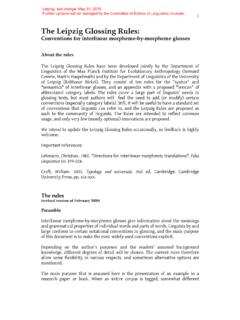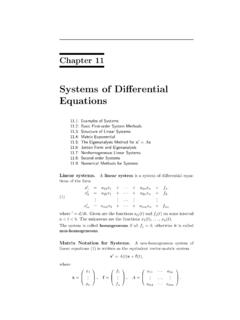Transcription of Understanding and sharing intentions: The origins of ...
1 Human beings are the world s experts at mind reading. Ascompared with other species, humans are much more skill-ful at discerning what others are perceiving, intending, de-siring, knowing, and believing. Although the pinnacle ofmind reading is Understanding beliefs as beliefs are in-disputably mental and normative the foundational skill isunderstanding intentions. Understanding intentions isfoundational because it provides the interpretive matrix fordeciding precisely what it is that someone is doing in thefirst place.
2 Thus, the exact same physical movement may beseen as giving an object, sharing it, loaning it, moving it, get-ting rid of it, returning it, trading it, selling it, and on andon depending on the goals and intentions of the whereas Understanding beliefs does not emerge untilaround age 4 in human ontogeny, Understanding intentionsbegins to emerge at around a child s first beings are also the world s experts at culture. Hu-mans do not just interact with conspecifics socially, as domany animal species, but they also engage with them in com-plex collaborative activities such as making a tool together,preparing a meal together, building a shelter together, play-ing a cooperative game, collaborating scientifically, and onand on.
3 These collective activities and practices are oftenstructured by shared symbolic artifacts, such as linguisticsymbols and social institutions, facilitating their transmis-sion across generations in ways that ratchet them up incomplexity over historical time. Children become more skill-ful at collaborating and interacting with others culturallythroughout early childhood, but their first nascent attemptsbegin, once again, at around the first et al. (1993) argued and presented evidencethat these two dimensions of human expertise reading in-tentions and interacting with others culturally are inti-mately related.
4 Specifically, the way humans understandthe intentional actions and perceptions of others createsspecies-unique forms of cultural learning and engagement,which then lead to species-unique processes of culturalcognition and evolution. For example, it is only if a youngchild understands other persons as intentional agents thatshe can acquire and use linguistic symbols because thelearning and use of symbols requires an Understanding thatthe partner can voluntarily direct actions and attention tooutside entities.
5 Indeed, material and symbolic artifacts ofall kinds, including even complex social institutions, are inan important sense intentionally constituted (Bloom 1996;Searle 1995; Tomasello 1999a).Recently, however, some new empirical findings haveemerged which suggest that Understanding intentions can-not be the whole story of cultural cognition. Briefly, themain finding is that some nonhuman primates understandmore about intentional action and perceptions than waspreviously believed (and this is also true, to some degree, ofBEHAVIORAL AND BRAIN SCIENCES(2005) 28, 675 735 Printed in the United States of America 2005 Cambridge University Press0140-525X/05 $ and sharingintentions.)
6 The origins ofcultural cognitionMichael Tomasello, Malinda Carpenter, Josep Call,Tanya Behne, and Henrike MollMax Planck Institute for Evolutionary Anthropology, D-04103 propose that the crucial difference between human cognition and that of other species is the ability to participate withothers in collaborative activities with shared goals and intentions: shared intentionality. Participation in such activities requires not onlyespecially powerful forms of intention reading and cultural learning, but also a unique motivation to share psychological states with oth-ers and unique forms of cognitive representation for doing so.
7 The result of participating in these activities is species-unique forms ofcultural cognition and evolution, enabling everything from the creation and use of linguistic symbols to the construction of social normsand individual beliefs to the establishment of social institutions. In support of this proposal we argue and present evidence that greatapes (and some children with autism) understand the basics of intentional action, but they still do not participate in activities involvingjoint intentions and attention (shared intentionality).
8 Human children s skills of shared intentionality develop gradually during the first14 months of life as two ontogenetic pathways intertwine: (1) the general ape line of Understanding others as animate, goal-directed, andintentional agents; and (2) a species-unique motivation to share emotions, experience, and activities with other persons. The develop-mental outcome is children s ability to construct dialogic cognitive representations, which enable them to participate in earnest in thecollectivity that is human :collaboration; cooperation; cultural learning; culture; evolutionary psychology; intentions; shared intentionality; social cog-nition; social learning; theory of mind; joint attentionchildren with autism).
9 But they do not thereby engage so-cially and culturally with others in the ways that humanchildren do. Therefore, Understanding the intentional ac-tions and perceptions of others is not by itself sufficient toproduce humanlike social and cultural activities. Some-thing additional is hypothesis for this something additional is sharedintentionality. We propose that human beings, and only hu-man beings, are biologically adapted for participating in col-laborative activities involving shared goals and socially co-ordinated action plans (joint intentions).
10 Interactions ofthis type require not only an Understanding of the goals, in-tentions, and perceptions of other persons, but also, in ad-dition, a motivation to share these things in interaction withothers and perhaps special forms of dialogic cognitiverepresentation for doing so. The motivations and skills forparticipating in this kind of we intentionality are woveninto the earliest stages of human ontogeny and underlieyoung children s developing ability to participate in the col-lectivity that is human this article, we explicate and elaborate this account ofhow humans come to (1) understand intentional action and(2)


